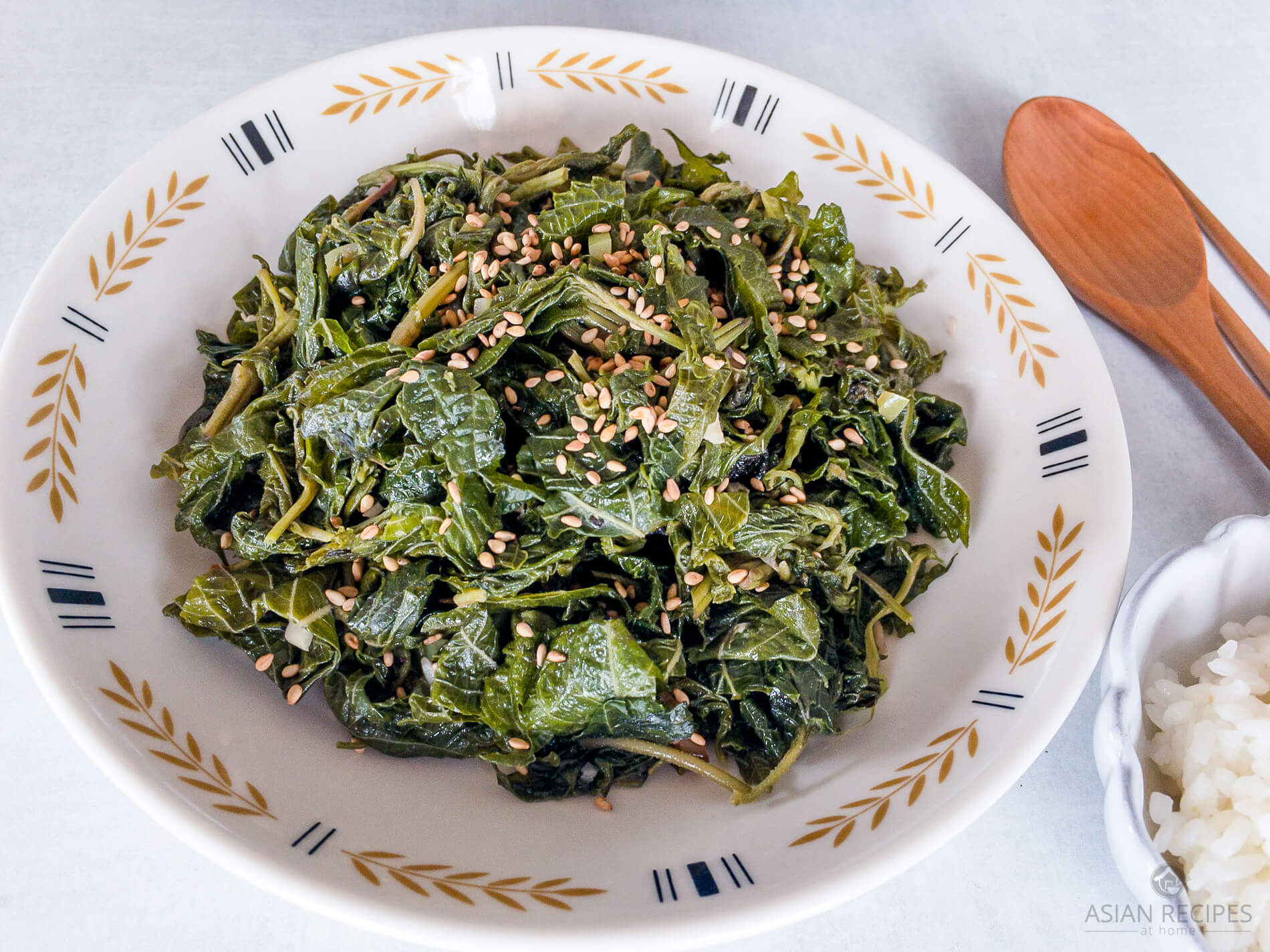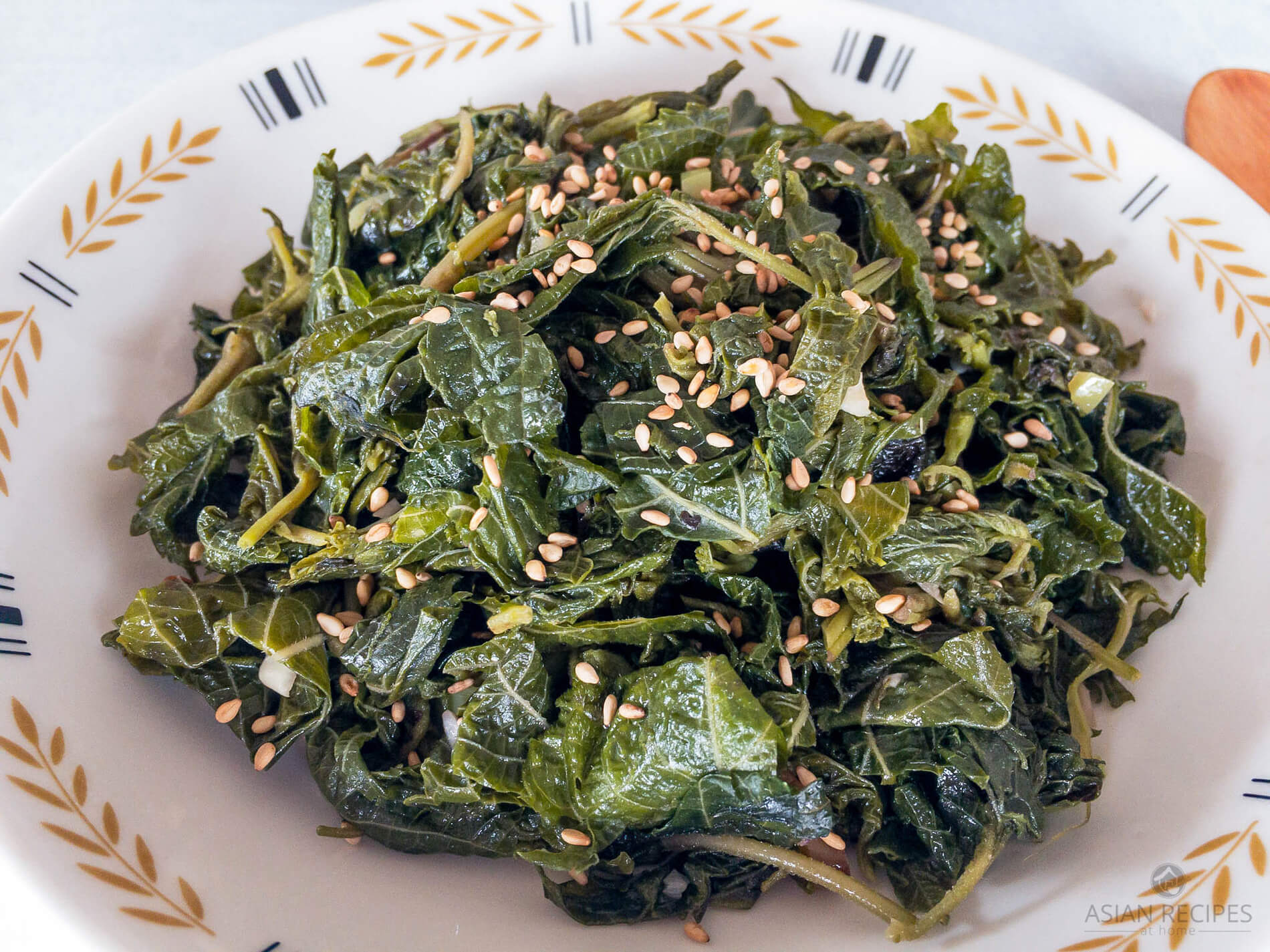Asian-style stir-fried sesame leaves are a delicious way to add a unique green vegetable to your diet. This recipe makes for a great side dish and would also be great mixed into a bibimbap bowl.
Our Asian-style stir-fried sesame seed leaves recipe
This is such an easy and delicious vegetable recipe. We use common Asian-style ingredients to create this stir-fried side dish (banchan). If you do a lot of Asian cooking at your house already, then you probably already have most of the ingredients on hand. You’ll just need the fresh sesame (perilla) leaves.
If you’ve never tried sesame (perilla) leaves before then this would be a great introduction recipe. We take freshly picked leaves and boil them first to parcook the leaves before stir-frying. It’s totally worth the few minutes of extra time to parcook the leaves though because we are helping to release some of the water from the fresh leaves. If you started to stir-fry the fresh leaves without parcooking them, they would release so much water during the stir-fry process that the stir-fry would become watery. Not ideal!
What are sesame (perilla) leaves?
Sesame leaves are a common green vegetable in traditional Korean cuisine, and they’re prized for their high mineral content and distinctive aroma. It’s utilized as a herb, a lettuce, and a typical vegetable at times.
Perilla is a word that refers to a variety of different mint species. The Japanese utilize shiso, which is smaller and more delicate than the Koreans’ preferred large, rounder perilla leaves.
What do sesame leaves taste like?
The flavor of sesame leaves (also known as kkaenip herb in Korean) is comparable to that of fennel. They have a licorice flavor that is slightly exotic. They have a nutty fragrance and are as aromatic as herbs like basil and mint.
Where to find sesame leaves (perilla)?
Sesame (perilla) leaves are difficult to find in most of the common/chain grocery stores. The best places where you can possibly find these sesame leaves are at a local farmer’s market or a local Asian/Korean market. You may also be able to find it growing on your own land and can forage/pick these yourself (where it is safe and legal). If you can’t find fresh sesame leaves where you live then you may want to consider growing the plants yourself. It is really easy to grow in most areas. See more information on growing them yourself below!
Grow your own sesame (perilla) leaves!
They’re easy to grow in pots or in your garden. It thrives in warm conditions and does best under partial shade if the heat is particularly harsh where you live. It’s also preferable to plant them directly rather than transplanting them. Seeds can be purchased via Korean supermarkets, Amazon (here are some), or other seed providers such as Kitazawa Seed Company. You can harvest seeds for the next year after your plants are completely established!
HUNGRY FOR MORE? Subscribe to our newsletter and follow along on Facebook, Pinterest, Twitter, and Instagram for all of the latest updates.

Asian-style Stir-fried Sesame (Perilla) Leaves
Asian-style stir-fried sesame leaves are a delicious way to add a unique green vegetable to your diet. This recipe makes for a great side dish and would also be great mixed into a bibimbap bowl.
Ingredients
- ½ lb fresh sesame seed leaves
- 2 banana peppers, seeds removed & sliced thinly
- 2 garlic cloves, minced (about 2 tsp)
- 3 Tbsp avocado oil
- 1 tsp toasted sesame seeds
Stir-fry sauce:
- 2 tsp salt
- ¼ tsp ground black pepper
- 1 Tbsp fish sauce
- 2 tsp mushroom umami powder (or Dasida beef soup stock powder)
- 1 Tbsp coconut aminos
Instructions
- Bring water to a boil. Add the sesame seed leaves once the water comes to a boil and boil until the leaves are tender. About 5 minutes if they’re younger leaves, or 7 minutes for older leaves. Drain and rinse with cold water to stop the cooking. Wash and rinse the leaves with cold water until well-washed - we repeat the wash/rinse process about 5 times.
- Squeeze out the water as much as possible from the leaves. Try to do this as gently as possible as to not rip or mash the leaves.
- Cut the leaves into about ½ inch wide slices. This should make about 2 cups of leaves.
- Place a frying pan on medium-high heat. Add the avocado oil to the bottom of the pan. When the pan is warm, add in the sesame seed leaves. Stir-fry for about 3 minutes.
- Next, turn down the heat to low, and continue stir-frying for about 6-7 minutes.
- Add in the garlic and sliced banana peppers. Continue stir-frying for about 2-3 minutes.
- Add in the stir-fry sauce into the pan with everything else and continue stir-frying for another 3-4 minutes.
- Remove from heat and enjoy. Top with toasted sesame seeds.
We love seeing your creations from our recipes! Tag us on Instagram at @AsianRecipesAtHome.
Disclaimer: Under no circumstances shall this website and the author(s) be responsible for any loss or damages resulting from the reliance of the given nutritional information or ingredient/product recommendations. Recommended ingredients/products can change their formula at any time without this website and author’s awareness. It is your responsibility (the reader’s) to check the label/ingredients of any product prior to purchasing and/or using. We greatly appreciate your support and understanding.



2 comments
Thanks for posting this recipe. I bought a bag of perilla leaves and didn’t feel to marinate them all. The recipe turned out nicely, albeit a bit too salty for mu taste even though a halved the amount of salt. I replaced coconut amino by soy sauce for soup (in lack of a better alternative), so maybe this contributed to the saltiness.
Hi Catherine! Thanks for trying out our recipe! I would definitely think that using soy sauce in place of coconut aminos would have contributed to it being a bit more salty. Coconut aminos has a natural sweetness as well, which can help to balance out the saltiness. If you use soy sauce in the future, definitely start with halving the amount, and maybe also add a little bit of sugar to help balance it all out. Thanks again for trying our sesame (perilla) leaves recipe!